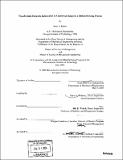| dc.contributor.advisor | Daniel E. Whitney and Roy E. Welsch. | en_US |
| dc.contributor.author | Balazs, Brett A. (Brett Alan), 1973- | en_US |
| dc.contributor.other | Leaders for Manufacturing Program. | en_US |
| dc.date.accessioned | 2006-11-08T16:32:13Z | |
| dc.date.available | 2006-11-08T16:32:13Z | |
| dc.date.copyright | 2004 | en_US |
| dc.date.issued | 2004 | en_US |
| dc.identifier.uri | http://hdl.handle.net/1721.1/34752 | |
| dc.description | Thesis (S.M.)--Massachusetts Institute of Technology, Sloan School of Management; and, (S.M.)--Massachusetts Institute of Technology, Dept. of Mechanical Engineering; in conjunction with the Leaders for Manufacturing Program at MIT, 2004. | en_US |
| dc.description | Includes bibliographical references (p. 83). | en_US |
| dc.description.abstract | In a complex production process attached to every unit are considerable quantities of data that provide many details regarding process performance. On many occasions, although this data is collected in a database or in some cases manually, output is never generated from this data. Often the data is reviewed by operators or engineers but because of its complexity no real conclusions are drawn from it and hence the data is never used to take action or make appropriate decisions. This work explores the theme that the use of information transformed from data is critical in making the necessary decisions and actions in a problem solving process. This methodology is carried out in solving significant yield and rate problems of a ribbon bonding process used to produce state-of-the-art surface radars at Raytheon Company. Transforming data into information particularly through the use of visual tools became essential in determining root causes by bringing forward underlying issues. This led to increased confidence in making the right decisions and ultimately led to implementation of process improvement solutions. Work for this thesis resulted in several process improvement initiatives as well as the implementation of an automated data management tool designed using extensive visual controls to provide real-time process feedback to operators. The process improvement initiatives involved implementation of a new cleaning process prior to ribbon bonding as well as the design, manufacture, and implementation of a work stage that added heat to the bonding process. These process improvement initiatives resulted in the elimination of the yield and rate problems and led to cost avoidance savings of over $2.6M for the first two radars. More importantly, the | en_US |
| dc.description.abstract | (cont.) lessons learned from the methodology introduced in this work and used to solve ribbon bond process problems will lead to lower production costs on all future radars. Thesis Supervisor: Daniel E. Whitney | en_US |
| dc.description.statementofresponsibility | by Brett A. Balazs. | en_US |
| dc.format.extent | 83 p. | en_US |
| dc.format.extent | 4640673 bytes | |
| dc.format.extent | 4648167 bytes | |
| dc.format.mimetype | application/pdf | |
| dc.format.mimetype | application/pdf | |
| dc.language.iso | eng | en_US |
| dc.publisher | Massachusetts Institute of Technology | en_US |
| dc.rights | M.I.T. theses are protected by copyright. They may be viewed from this source for any purpose, but reproduction or distribution in any format is prohibited without written permission. See provided URL for inquiries about permission. | en_US |
| dc.rights.uri | http://dspace.mit.edu/handle/1721.1/7582 | |
| dc.subject | Sloan School of Management. | en_US |
| dc.subject | Mechanical Engineering. | en_US |
| dc.subject | Leaders for Manufacturing Program. | en_US |
| dc.title | Transforming data into information to control and improve a ribbon bonding process | en_US |
| dc.type | Thesis | en_US |
| dc.description.degree | S.M. | en_US |
| dc.contributor.department | Leaders for Manufacturing Program at MIT | en_US |
| dc.contributor.department | Massachusetts Institute of Technology. Department of Mechanical Engineering | |
| dc.contributor.department | Sloan School of Management | |
| dc.identifier.oclc | 56607222 | en_US |
